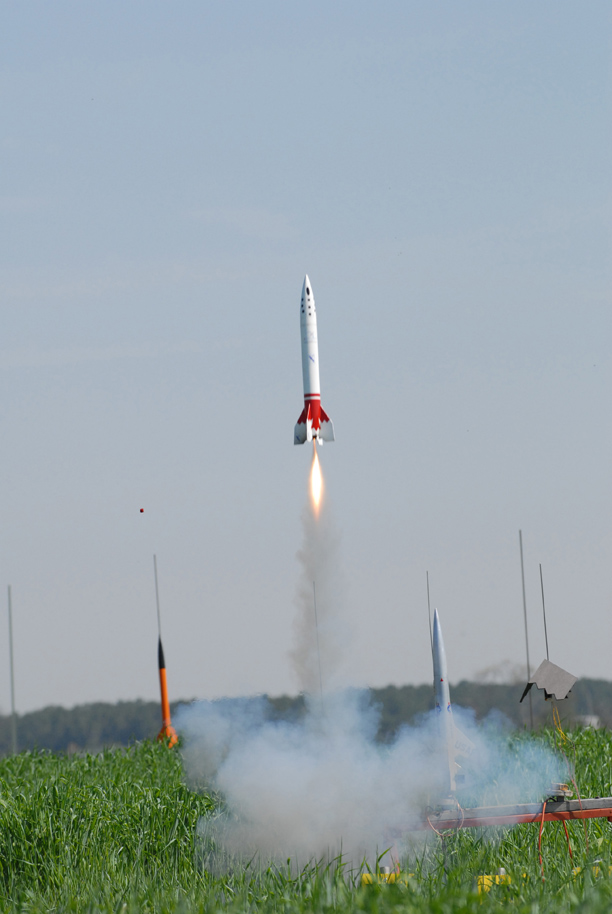![]()

5-4-3-2-1, puff of smoke, a throaty roar, and the rocket motor instantly comes up to pressure, pushing the rocket into the blue sky’s abyss. After an eternity and just before the tickle of vomit in your stomach, a pop is echoed down from the heavens and the recovery mechanism successfully deploys. SUCCESS!, no, not yet! The rocket still must be retrieved. All the effort up to this point is meaningless if the rocket is lost. It is important to track the rockets ascent in order to track its descent. There are many tricks to help find the rocket.
Use brightly colored parachutes and streamers. Remember, the color must be easy to see against a blue sky, clouds, grass, trees, and the vast grain fields. Bright multicolor parachutes are common for this purpose. Also, neon orange is very easy to spot in most conditions. Unless the rocket will be used for turkey hunting, camouflage parachutes are not the way to go.
Another trick is to use a spotter. Enlist brothers, sons, nephews, and anyone else that might wander by to watch the rocket. The more eyes watching the rocket, the better the chances of keeping the rocket in sight. Once the eye loses the rocket, it is very difficult to pick it up again in the vastness of blue. Hopefully someone will keep the rocket in sight. After a rocket touches down, immediately line up two landmarks to create a line. Walk this line until the rocket is found.
Auto focusing binoculars are great for tracking rockets as well. It is very difficult to keep a high speed rocket in view but rather easy to use the binoculars to follow the engine’s smoke trail up to the rocket. Keep the binoculars on the rocket for its entire descent and then use the naked eye right before the rocket touches down.
The binoculars will vastly distort distance and it might become difficult to find it. Some binoculars will have a built in compass so a bearing can be taken. Follow the bearing until you step on your rocket.
Some rocketeers will deploy tracking powder as an aid to spot the rocket at apogee. Carpenter’s red powder chalk dust works great. Use a coffee filter or paper towel between the parachute and nosecone and fill with the brightly colored chalk dust. Other rocketeers will deploy brightly colored smoke (available at military surplus stores) at apogee for extreme altitudes.

Personal alarms are used as well. These alarms will screech an ear piercing noise and can be rigged so that the pin is pulled at parachute deployment. Personal alarms are great when flying in fields with tall crops but are ineffective when the rocket drifts out of ear shot.
Electronics can be used to recover rockets as well. Some rockets will travel so high that even Steve Austin with his 6-million dollar bionic eye will never see it. This is where electronics come to the rescue. The most common are radio tracking devices. However, more and more rockets are being equipped with GPS transmitters that simply beam back the landing coordinates. The coordinates are then punched into a GPS handheld where it becomes a very simple matter of locating your rocket. When it comes to rocket electronics, only the sky and your wallet are the limit.
If the rocket comes to a rest in the power lines, call the local electric utility. Do not attempt to recover it yourself. Also, if the rocket lands in the tree, (usually the tip top), and cannot be reached, hire a local tree company to climb up and retrieve it. No rocket is worth the risk of life and limb.
Once a rocket is successfully retrieved, inspect it closely for any damage. Pack up the rocket and start the trek back to the flight line. Do not forget to puff out your chest and break a smile on your face. You just overcame all the obstacles and challenges with a successful rocket flight. Congratulations! Drink a beer and start contemplating the next flight.
Proper Planning leads to perfect liftoff